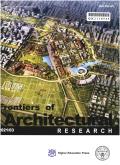Urban geometry as a climate adaptation strategy for enhancing outdoor thermal comfort in a hot desert climate
IF 3.6
1区 艺术学
0 ARCHITECTURE
引用次数: 0
Abstract
This study aimed to assess the impact of varying street canyon geometries on outdoor thermal comfort in two Egyptian cities with distinct climates: Aswan, located in the southern desert region, and Alexandria, on the northern coast. The design of urban street canyons in Egypt often neglects the country's diverse climatic regions. The investigation focused on four height-to-width aspect ratios and four principal street orientations in the two cities. Field data, ENVI-met microclimate software, and RayMan were utilized to analyze the impact of hypothesized scenarios on heat stress in the studied street canyons. Outdoor thermal comfort was evaluated using the physiologically equivalent temperature (PET). The findings demonstrated the effectiveness of aspect ratio and orientation in the respective cities. In Aswan, the aspect ratio had a greater influence on comfort, with aspect ratio of 2.5 providing the most favorable conditions and a ratio of 1 resulting in the least comfortable conditions. Conversely, in Alexandria, the street canyon orientation proved more advantageous, where a northwest-southeast orientation produced a significant decrease (10 K) in PET compared to the least favorable orientation. These results highlight the importance of considering local climatic factors in the design of urban street canyons to effectively mitigate outdoor heat stress.
城市几何作为一种气候适应策略,在炎热的沙漠气候中增强室外热舒适性
本研究旨在评估不同街道峡谷几何形状对两个不同气候的埃及城市室外热舒适的影响:位于南部沙漠地区的阿斯旺和位于北部海岸的亚历山大。埃及城市街道峡谷的设计往往忽略了该国多样化的气候区域。调查的重点是两个城市的四种高宽比和四种主要街道朝向。利用现场数据、ENVI-met微气候软件和RayMan分析了假设情景对所研究街道峡谷热应力的影响。采用生理等效温度(PET)评价室外热舒适性。研究结果证明了纵横比和方位在各个城市的有效性。在阿斯旺,纵横比对舒适度的影响更大,纵横比为2.5提供了最有利的条件,而纵横比为1则导致了最不舒适的条件。相反,在亚历山大,街道峡谷方向被证明是更有利的,其中西北-东南方向与最不利的方向相比,PET显著降低(10 K)。这些结果强调了在城市街道峡谷设计中考虑当地气候因素以有效缓解室外热应力的重要性。
本文章由计算机程序翻译,如有差异,请以英文原文为准。
求助全文
约1分钟内获得全文
求助全文
来源期刊

Frontiers of Architectural Research
ARCHITECTURE-
CiteScore
6.20
自引率
2.90%
发文量
430
审稿时长
30 weeks
期刊介绍:
Frontiers of Architectural Research is an international journal that publishes original research papers, review articles, and case studies to promote rapid communication and exchange among scholars, architects, and engineers. This journal introduces and reviews significant and pioneering achievements in the field of architecture research. Subject areas include the primary branches of architecture, such as architectural design and theory, architectural science and technology, urban planning, landscaping architecture, existing building renovation, and architectural heritage conservation. The journal encourages studies based on a rigorous scientific approach and state-of-the-art technology. All published papers reflect original research works and basic theories, models, computing, and design in architecture. High-quality papers addressing the social aspects of architecture are also welcome. This journal is strictly peer-reviewed and accepts only original manuscripts submitted in English.
 求助内容:
求助内容: 应助结果提醒方式:
应助结果提醒方式:


